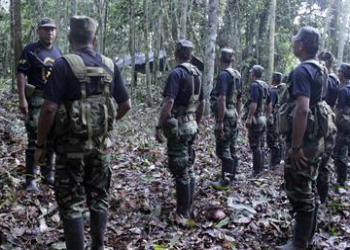Guerrillas of Peru’s Shining Path rebels recently killed three policemen in the country’s main coca-producing region, a sign that the group intends to defend its hold on Peru’s criminally lucrative territories amid expanding coca production in the South American country.
Shining Path snipers attacked a police convoy on March 18, leaving three officers dead, reported El País. The convoy was carrying agents of the Special Anti-Drug Operations Division (División de Operaciones Especiales Antidrogas) from their headquarters in the Apurimac, Ene and Mantaro River Valleys (VRAEM), a region known to be the country’s biggest coca-producing area.
Deputy Interior Minister Rubén Vargas said that “the terrorist attack is a result of the effective operations carried out against drug trafficking in the VRAEM,” adding that during the past week and a half alone, the police have seized over two tons of cocaine produced in the region.
Meanwhile on March 19, security forces seized 1,417 kilograms of cocaine allegedly bound for the United States and Belgium in the port city of Callao, reported La República.
Authorities believe the cocaine had been sent from the VRAEM, and that the shipment, valued at an estimated $85 million, could belong to one of the 20 Italian mafia clans based in Spain’s Catalonia region.
InSight Crime Analysis
The assassination of the three policemen in the VRAEM is a sign that the Shining Path’s presence in Peru’s largest coca-growing region remains strong. And the multi-ton seizure in Callao highlights the role of the city as the main departure point for the country’s drug trade.
Peruvian authorities believe the country’s coca leaf cultivations might be growing for the first time since 2011. Any increase in drug production in the VRAEM has the potential of strengthening the last rebel cells operating in the area under the leadership of the Quispe Palomino brothers.
SEE ALSO: Peru News and Profile
Indeed, the Shining Path guerrillas have become increasingly involved in drug trafficking over the years, moving from taxation of the product transported through their strongholds to direct participation in the cocaine trade, in a manner that seems to mimic the strategy adopted by Colombia’s FARC and ELN rebels. While there appears to be no evidence of the Shining Path managing international drug routes, the insurgents have at times escorted drug shipments out of the VRAEM, sometimes in canoes or human caravans.
Authorities also believe that the air bridge that historically connected drug traffickers in the VRAEM with Bolivia has been interrupted. But field work carried out by InSight Crime in Peru indicates that, far from no longer operating, the planes that collect drugs in the region are simply landing in more secluded areas in and around the VRAEM, and no longer next to military bases as they used to do before.
SEE ALSO: Coverage of the Shining Path
In October 2016, Peru’s government decided to re-implement a state of emergency in the VRAEM, leaving the military again at the helm of the fight against drug trade in the region. The decision, however, might turn out to be counter-productive, as Peru’s armed forces have a long and ongoing history of participating in the cocaine trade.
While most of the drugs produced in the VRAEM are smuggled via airplane into Bolivia, a significant portion is sent to the coast. And Callao, Peru’s largest seaport, has become a key trade center where Mexicans and European traffickers negotiate drug prices.

